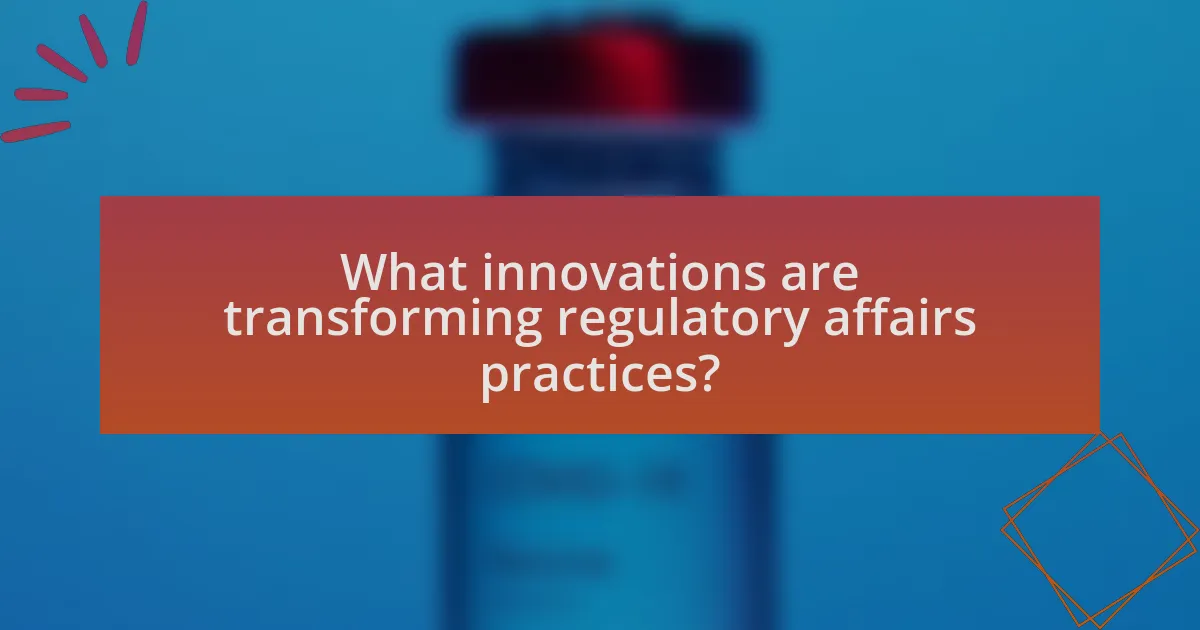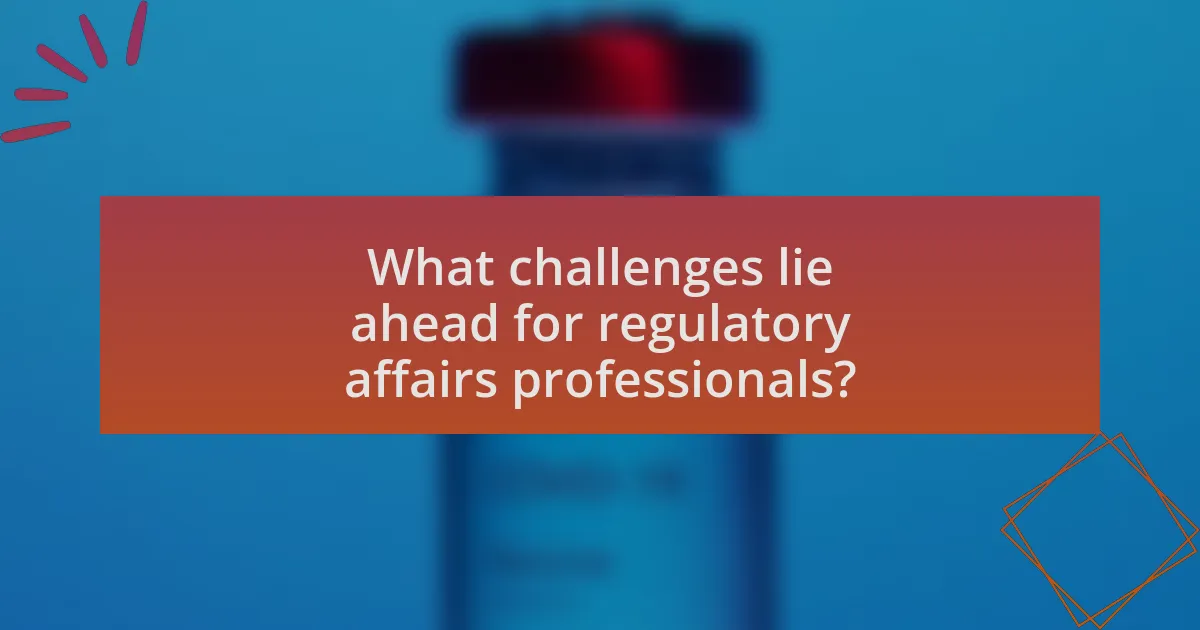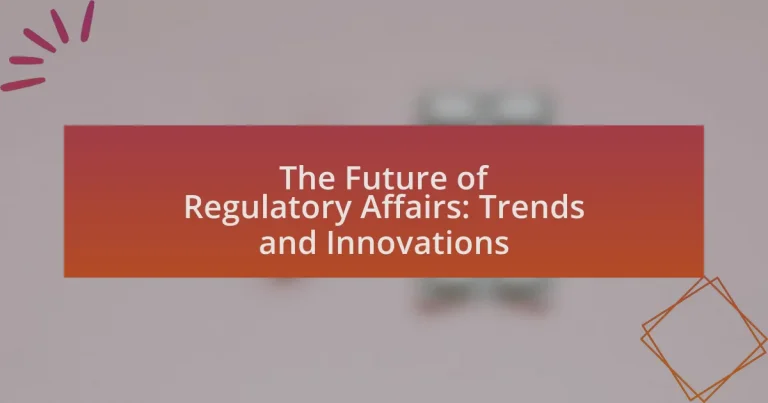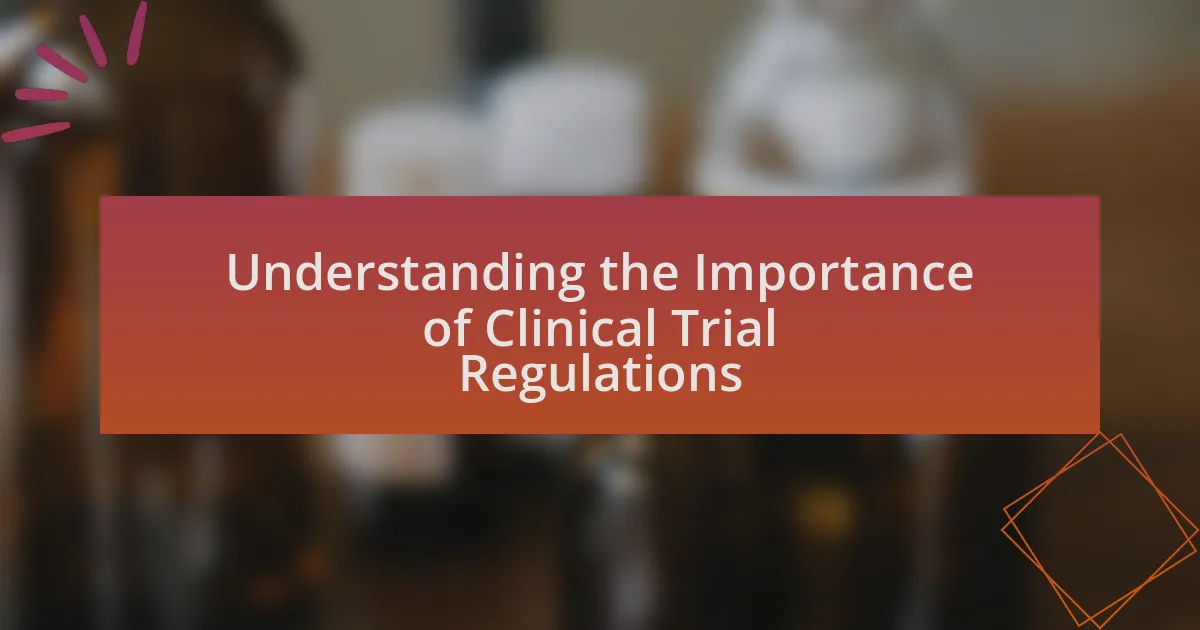The article focuses on the future of regulatory affairs, highlighting key trends and innovations that are shaping the field. It discusses the impact of digitalization, real-world evidence, and enhanced collaboration among stakeholders, emphasizing the role of artificial intelligence and machine learning in streamlining regulatory processes. The article also addresses the importance of stakeholder engagement, emerging compliance requirements, and the implications of increased regulatory scrutiny. Additionally, it explores how organizations can leverage technology and partnerships to improve compliance outcomes and adapt to evolving regulations, ultimately fostering a culture of compliance within the industry.
What are the key trends shaping the future of regulatory affairs?

Key trends shaping the future of regulatory affairs include increased digitalization, a focus on real-world evidence, and enhanced collaboration among stakeholders. Digitalization is transforming regulatory processes through the use of advanced technologies like artificial intelligence and machine learning, which streamline data analysis and improve decision-making efficiency. The emphasis on real-world evidence is growing as regulators seek to incorporate data from actual patient experiences to inform approvals and post-market surveillance. Additionally, collaboration among industry, regulatory bodies, and healthcare professionals is becoming essential to address complex challenges and ensure patient safety, as evidenced by initiatives like the FDA’s Patient Engagement Advisory Committee. These trends reflect a shift towards more agile, data-driven, and collaborative regulatory frameworks.
How is technology influencing regulatory affairs?
Technology is significantly influencing regulatory affairs by streamlining processes, enhancing data management, and improving compliance monitoring. Advanced technologies such as artificial intelligence and machine learning enable regulatory bodies to analyze vast amounts of data quickly, facilitating faster decision-making and risk assessment. For instance, the use of AI in pharmacovigilance allows for real-time monitoring of drug safety, which can lead to quicker responses to adverse events. Additionally, digital platforms and electronic submissions have reduced the time and resources required for regulatory approvals, as evidenced by the FDA’s adoption of electronic submissions, which increased efficiency and transparency in the review process.
What role do artificial intelligence and machine learning play in regulatory processes?
Artificial intelligence and machine learning significantly enhance regulatory processes by automating data analysis, improving decision-making, and increasing efficiency. These technologies enable regulators to process vast amounts of data quickly, identify patterns, and predict outcomes, which leads to more informed regulatory decisions. For instance, AI algorithms can analyze clinical trial data to identify potential safety issues faster than traditional methods, thereby expediting the approval process for new drugs. Additionally, machine learning models can continuously learn from new data, allowing for adaptive regulatory frameworks that respond to emerging trends and risks in real-time. This integration of AI and machine learning into regulatory processes not only streamlines operations but also enhances the overall effectiveness of regulatory oversight.
How are digital platforms changing the landscape of regulatory submissions?
Digital platforms are transforming the landscape of regulatory submissions by streamlining processes, enhancing data management, and improving collaboration among stakeholders. These platforms enable real-time data sharing and communication, which accelerates the submission process and reduces the time required for regulatory approvals. For instance, the use of electronic submission systems has been shown to decrease the average review time by up to 30%, as reported by the FDA in their 2020 report on electronic submissions. Furthermore, digital platforms facilitate better tracking and management of submission documents, ensuring compliance with regulatory requirements and minimizing errors. This shift towards digitalization not only increases efficiency but also enhances transparency and accountability in the regulatory process.
What regulatory changes are expected in the coming years?
Regulatory changes expected in the coming years include increased emphasis on digital health regulations, particularly concerning telemedicine and digital therapeutics. Regulatory bodies like the FDA are adapting frameworks to accommodate the rapid growth of technology in healthcare, which includes streamlining approval processes for software as a medical device. Additionally, there is a trend towards more stringent data privacy regulations, influenced by global standards such as the GDPR, which will likely affect how companies manage patient data. These changes are driven by the need for enhanced patient safety and the integration of innovative technologies into healthcare systems.
How are global harmonization efforts impacting regulatory frameworks?
Global harmonization efforts are significantly impacting regulatory frameworks by promoting consistency and efficiency across different jurisdictions. These efforts, such as those led by the International Council for Harmonisation of Technical Requirements for Pharmaceuticals for Human Use (ICH), aim to align regulatory standards, which reduces duplication of testing and accelerates the approval process for new products. For instance, the adoption of ICH guidelines has led to a more streamlined approach in drug development, allowing companies to submit a single set of data that meets the requirements of multiple regulatory agencies. This harmonization not only enhances global trade but also improves patient access to innovative therapies by shortening the time to market.
What new compliance requirements are emerging for industries?
New compliance requirements emerging for industries include stricter data privacy regulations, enhanced environmental sustainability standards, and increased transparency mandates. For instance, the General Data Protection Regulation (GDPR) in Europe has set a precedent for data protection laws globally, compelling companies to adopt rigorous data handling practices. Additionally, the rise of the Sustainable Finance Disclosure Regulation (SFDR) in the EU mandates financial market participants to disclose sustainability risks, reflecting a growing emphasis on environmental accountability. These developments indicate a trend towards more comprehensive regulatory frameworks that prioritize consumer protection and environmental stewardship.
Why is stakeholder engagement becoming more critical in regulatory affairs?
Stakeholder engagement is becoming more critical in regulatory affairs due to the increasing complexity of regulations and the need for collaborative decision-making. As regulatory environments evolve, involving stakeholders such as industry representatives, healthcare professionals, and patient advocacy groups ensures that diverse perspectives are considered, leading to more effective and inclusive regulatory outcomes. Research indicates that effective stakeholder engagement can enhance compliance, reduce delays in approval processes, and foster trust between regulators and the public, ultimately improving the overall quality of regulatory frameworks.
How can organizations effectively communicate with regulators?
Organizations can effectively communicate with regulators by establishing clear, transparent, and consistent channels of communication. This involves regularly engaging with regulatory bodies through formal meetings, written correspondence, and public consultations to ensure that all parties are aligned on expectations and requirements.
For instance, the Pharmaceutical Research and Manufacturers of America (PhRMA) emphasizes the importance of proactive dialogue with the FDA to facilitate timely approvals and address any concerns early in the process. Additionally, organizations can utilize technology, such as regulatory compliance software, to streamline communication and maintain accurate records of interactions, which enhances accountability and traceability.
Research indicates that organizations that prioritize open communication with regulators are more likely to achieve compliance and foster positive relationships, ultimately leading to smoother regulatory processes and reduced time to market for new products.
What strategies can be employed to enhance public trust in regulatory processes?
Enhancing public trust in regulatory processes can be achieved through transparency, stakeholder engagement, and accountability. Transparency involves making regulatory decisions and processes accessible and understandable to the public, which can be supported by initiatives like open data platforms that allow citizens to view regulatory activities and outcomes. Stakeholder engagement ensures that the voices of affected communities are heard, fostering a sense of inclusion and collaboration; for instance, public consultations and feedback mechanisms can be implemented to gather input from diverse groups. Accountability can be reinforced by establishing clear standards for regulatory performance and mechanisms for oversight, such as independent audits and regular reporting on regulatory effectiveness. These strategies collectively contribute to building a more trustworthy regulatory environment, as evidenced by studies showing that increased transparency and engagement correlate with higher levels of public confidence in regulatory institutions.
What innovations are transforming regulatory affairs practices?

Innovations transforming regulatory affairs practices include the adoption of artificial intelligence, advanced data analytics, and digital submission platforms. Artificial intelligence enhances decision-making by automating routine tasks and analyzing large datasets, which improves efficiency and accuracy in compliance processes. Advanced data analytics allows regulatory professionals to derive insights from complex data, facilitating risk assessment and regulatory strategy development. Digital submission platforms streamline the submission process, reducing time and costs associated with regulatory approvals. These innovations are supported by industry reports indicating that organizations leveraging these technologies experience faster approval times and improved regulatory compliance outcomes.
How are data analytics being utilized in regulatory decision-making?
Data analytics are utilized in regulatory decision-making by enabling agencies to analyze large datasets for insights that inform policy and compliance. For instance, regulatory bodies like the FDA use data analytics to monitor drug safety and efficacy by analyzing adverse event reports and clinical trial data, which helps in making informed decisions about drug approvals and market withdrawals. This approach enhances transparency and efficiency in the regulatory process, as evidenced by the FDA’s Sentinel Initiative, which employs data analytics to track the safety of medical products in real-time, thereby improving public health outcomes.
What types of data are most valuable for regulatory analysis?
The most valuable types of data for regulatory analysis include compliance data, risk assessment data, and market surveillance data. Compliance data provides insights into adherence to regulations and standards, which is essential for evaluating organizational practices. Risk assessment data helps identify potential hazards and their impacts, enabling regulators to prioritize issues effectively. Market surveillance data offers information on product performance and safety in real-world conditions, which is crucial for ongoing regulatory oversight. These data types collectively enhance the ability to make informed regulatory decisions and ensure public safety.
How can predictive analytics improve compliance outcomes?
Predictive analytics can improve compliance outcomes by enabling organizations to identify potential risks and non-compliance issues before they occur. By analyzing historical data and trends, predictive models can forecast areas of concern, allowing companies to proactively address compliance gaps. For instance, a study by Deloitte found that organizations using predictive analytics in compliance management experienced a 30% reduction in compliance-related incidents. This demonstrates that leveraging data-driven insights can lead to more effective compliance strategies and better regulatory adherence.
What role does automation play in regulatory affairs?
Automation plays a crucial role in regulatory affairs by streamlining processes, enhancing efficiency, and ensuring compliance with regulatory requirements. It enables organizations to automate data collection, document management, and reporting tasks, significantly reducing the time and resources needed for regulatory submissions. For instance, automated systems can facilitate real-time tracking of regulatory changes and deadlines, which helps organizations stay compliant with evolving regulations. Additionally, automation minimizes human error, thereby increasing the accuracy of submissions and improving overall regulatory outcomes.
How can automation streamline the submission process?
Automation can streamline the submission process by reducing manual tasks and increasing efficiency. By implementing automated systems, organizations can ensure faster data entry, minimize errors, and enhance compliance with regulatory requirements. For instance, automated workflows can facilitate the collection and validation of necessary documents, allowing for quicker submissions to regulatory bodies. According to a study by the Regulatory Affairs Professionals Society, automation can decrease submission times by up to 30%, demonstrating its effectiveness in improving operational efficiency in regulatory affairs.
What are the potential risks associated with automation in regulatory practices?
The potential risks associated with automation in regulatory practices include loss of human oversight, data security vulnerabilities, and the potential for systemic errors. Loss of human oversight can lead to critical decisions being made without adequate context or understanding, which may result in non-compliance with regulations. Data security vulnerabilities arise from increased reliance on digital systems, making sensitive information susceptible to cyberattacks; for instance, the 2020 SolarWinds cyberattack highlighted how automated systems can be exploited. Systemic errors can occur when automated processes fail or produce incorrect outputs, potentially leading to widespread regulatory failures, as seen in instances where algorithmic bias has affected decision-making in various sectors.
How are collaborative platforms changing regulatory interactions?
Collaborative platforms are transforming regulatory interactions by facilitating real-time communication and data sharing among stakeholders. These platforms enable regulators, businesses, and other entities to collaborate more effectively, streamlining the regulatory process. For instance, the use of cloud-based tools allows for the immediate exchange of compliance documents and feedback, reducing delays and enhancing transparency. A study by the World Economic Forum highlights that such collaborative approaches can lead to a 30% reduction in the time required for regulatory approvals, demonstrating their significant impact on efficiency and responsiveness in regulatory affairs.
What benefits do collaborative tools offer to regulatory professionals?
Collaborative tools offer regulatory professionals enhanced communication, streamlined workflows, and improved document management. These tools facilitate real-time collaboration among team members, allowing for quicker decision-making and problem-solving. For instance, platforms like Microsoft Teams and Slack enable instant messaging and file sharing, which can significantly reduce the time spent on email exchanges. Additionally, collaborative tools often include features for version control and audit trails, ensuring that all changes to regulatory documents are tracked and easily accessible, which is crucial for compliance purposes. Studies have shown that organizations utilizing collaborative tools can increase productivity by up to 30%, highlighting their effectiveness in regulatory environments where accuracy and efficiency are paramount.
How can organizations leverage partnerships to enhance regulatory compliance?
Organizations can leverage partnerships to enhance regulatory compliance by collaborating with industry experts and regulatory bodies to share knowledge and best practices. This collaboration allows organizations to stay informed about evolving regulations and compliance requirements, thereby reducing the risk of non-compliance. For instance, partnerships with legal firms or compliance consultants can provide organizations with tailored guidance on navigating complex regulatory landscapes. Additionally, engaging in industry associations can facilitate access to resources, training, and networking opportunities that further strengthen compliance efforts. Such strategic alliances not only improve an organization’s understanding of regulatory frameworks but also foster a culture of compliance through shared accountability and resources.
What challenges lie ahead for regulatory affairs professionals?

Regulatory affairs professionals face significant challenges ahead, primarily due to evolving regulations and increased scrutiny from regulatory bodies. As industries such as pharmaceuticals and medical devices advance rapidly, professionals must navigate complex and changing compliance landscapes. For instance, the introduction of new technologies like artificial intelligence in drug development necessitates a deeper understanding of regulatory frameworks, which are often lagging behind technological advancements. Additionally, the globalization of markets requires professionals to be adept at managing diverse regulatory requirements across different jurisdictions, complicating the approval processes. These challenges are compounded by the need for continuous education and adaptation to maintain compliance in an increasingly dynamic environment.
How can regulatory professionals adapt to rapid technological changes?
Regulatory professionals can adapt to rapid technological changes by continuously updating their knowledge and skills through ongoing education and training. This adaptation is essential as technology evolves, impacting regulatory frameworks and compliance requirements. For instance, professionals can engage in specialized courses on emerging technologies such as artificial intelligence and blockchain, which are increasingly relevant in regulatory contexts. Additionally, participating in industry conferences and networking with peers can provide insights into best practices and innovative solutions. According to a report by the Regulatory Affairs Professionals Society, staying informed about technological advancements is crucial for effective regulatory oversight and ensuring public safety.
What skills will be essential for future regulatory affairs roles?
Essential skills for future regulatory affairs roles include strong analytical abilities, effective communication, and a deep understanding of regulatory frameworks. Analytical skills are crucial for interpreting complex regulations and assessing compliance risks, while effective communication is necessary for articulating regulatory requirements to stakeholders. A comprehensive understanding of evolving regulatory frameworks, particularly in areas like digital health and biotechnology, is increasingly important as these sectors grow. Additionally, proficiency in data management and familiarity with technology-driven solutions will enhance efficiency in regulatory processes. These skills are supported by the ongoing trend of regulatory agencies adapting to rapid technological advancements and globalization, necessitating a workforce that is both knowledgeable and adaptable.
How can continuous education and training be implemented effectively?
Continuous education and training can be implemented effectively by integrating structured learning pathways that align with organizational goals and employee needs. Organizations should assess skill gaps and establish tailored training programs that utilize a mix of online courses, workshops, and mentorship opportunities. Research indicates that companies with robust training programs experience a 24% higher profit margin compared to those without, highlighting the financial benefits of effective training. Additionally, leveraging technology such as Learning Management Systems (LMS) can facilitate easy access to resources and track progress, ensuring that employees remain engaged and accountable in their learning journey.
What are the implications of increased regulatory scrutiny?
Increased regulatory scrutiny leads to heightened compliance requirements for businesses. This scrutiny often results in organizations needing to invest more resources in compliance programs, which can increase operational costs. For instance, a study by the Regulatory Affairs Professionals Society found that companies in heavily regulated industries, such as pharmaceuticals, may see compliance costs rise by up to 20% annually due to stricter regulations. Additionally, increased scrutiny can lead to longer approval times for products, impacting market entry and competitiveness. Historical data indicates that following the implementation of the Dodd-Frank Act, financial institutions faced significant delays in product approvals, affecting their ability to respond swiftly to market changes.
How can organizations prepare for more rigorous compliance checks?
Organizations can prepare for more rigorous compliance checks by implementing comprehensive compliance management systems. These systems should include regular audits, employee training programs, and updated policies that align with current regulations. For instance, a study by the Compliance and Ethics Institute found that organizations with robust compliance frameworks are 50% less likely to face regulatory penalties. Additionally, leveraging technology such as compliance software can streamline monitoring and reporting processes, ensuring that organizations remain proactive in meeting regulatory requirements.
What strategies can mitigate the impact of regulatory penalties?
Implementing comprehensive compliance programs is a key strategy to mitigate the impact of regulatory penalties. These programs should include regular training for employees on regulatory requirements, thorough internal audits to identify potential compliance gaps, and the establishment of a culture of accountability within the organization. For instance, companies that invest in compliance training have been shown to reduce the likelihood of violations, as evidenced by a study from the Ethics & Compliance Initiative, which found that organizations with strong compliance programs experience 50% fewer incidents of misconduct. Additionally, maintaining open communication with regulatory bodies can facilitate better understanding and potentially lead to reduced penalties in case of violations.
What best practices can enhance regulatory affairs effectiveness?
Implementing a structured approach to regulatory affairs enhances effectiveness significantly. This includes establishing clear communication channels among stakeholders, which facilitates timely information sharing and decision-making. Additionally, utilizing regulatory intelligence tools allows organizations to stay updated on changing regulations, thereby ensuring compliance and reducing the risk of delays in product approvals.
Furthermore, continuous training and development of regulatory affairs professionals are crucial, as it equips them with the latest knowledge and skills necessary to navigate complex regulatory landscapes. According to a study published in the Journal of Regulatory Affairs, organizations that invest in employee training report a 30% increase in regulatory compliance efficiency.
Lastly, adopting a proactive risk management strategy helps identify potential regulatory challenges early, allowing for timely interventions and minimizing disruptions in the regulatory process.
How can organizations foster a culture of compliance?
Organizations can foster a culture of compliance by implementing comprehensive training programs that emphasize the importance of regulatory adherence. These programs should be designed to educate employees about relevant laws, regulations, and internal policies, ensuring that everyone understands their responsibilities. Research indicates that organizations with robust compliance training see a significant reduction in violations; for instance, a study by the Ethics & Compliance Initiative found that companies with effective training programs experience 50% fewer compliance issues. Additionally, organizations should promote open communication channels where employees feel safe reporting concerns without fear of retaliation, further reinforcing a commitment to compliance.
What tools and resources are available to support regulatory professionals?
Regulatory professionals have access to various tools and resources designed to enhance their efficiency and compliance capabilities. These include regulatory management software, which streamlines the submission and tracking of regulatory documents, and databases that provide up-to-date information on regulations and guidelines across different regions. Additionally, training programs and workshops offered by professional organizations, such as the Regulatory Affairs Professionals Society (RAPS), equip professionals with the latest knowledge and skills necessary for navigating complex regulatory landscapes. Furthermore, online platforms and forums facilitate networking and knowledge sharing among regulatory professionals, fostering collaboration and best practices in the field.





